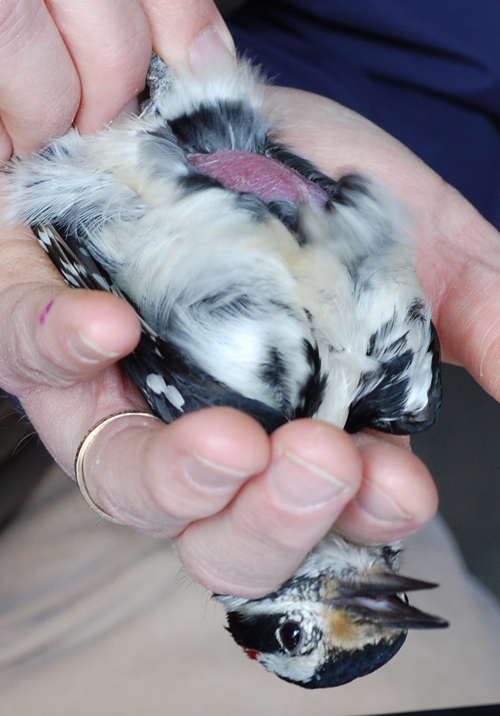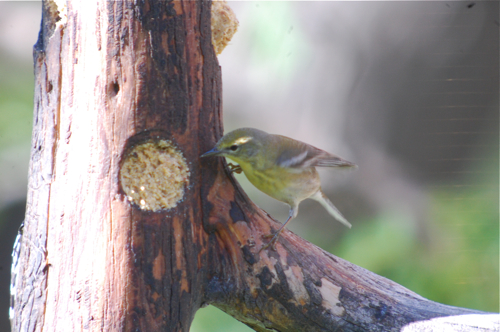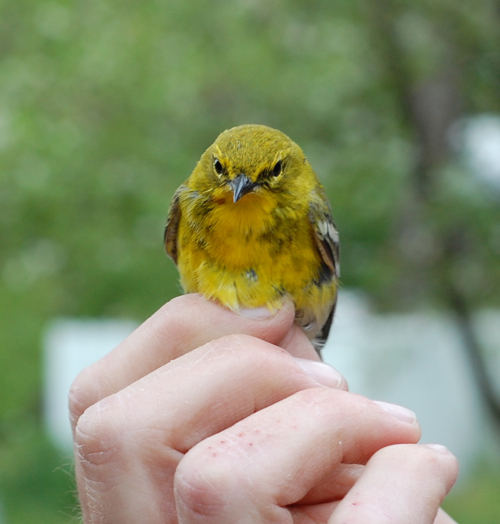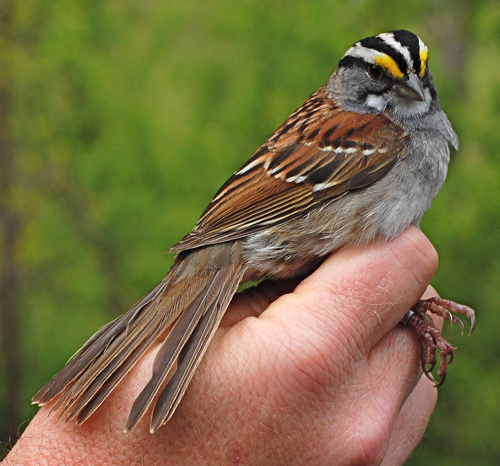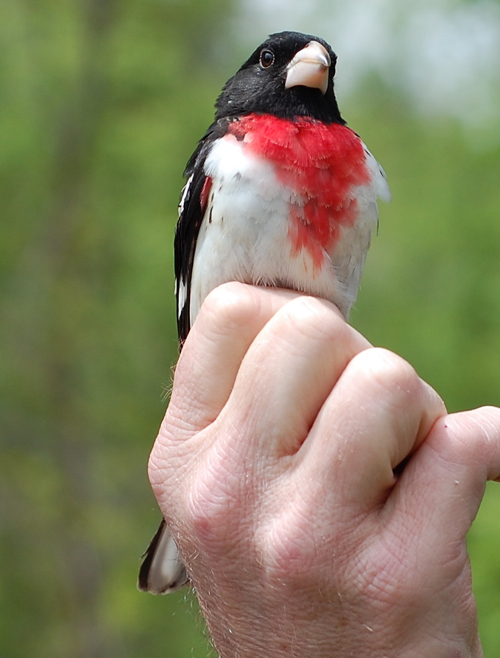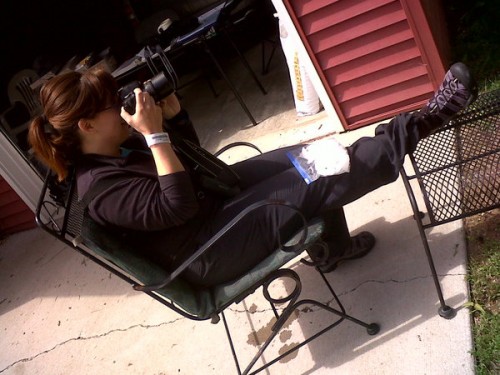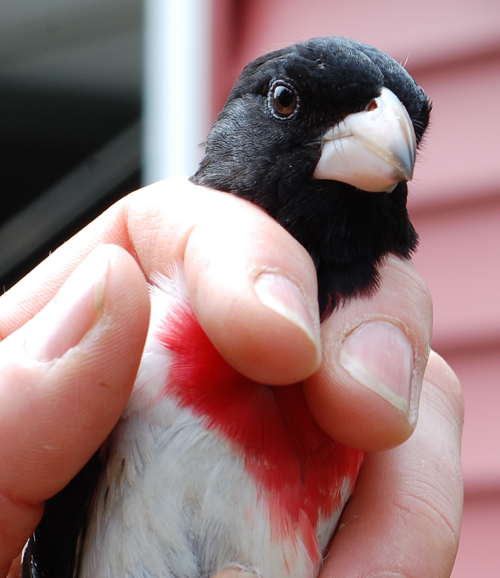Quick notes first:
My buddy Amber can be seen in an odd photo I took of a Mandrake Carrot at Lorraine's blog and Mr. Neil's blog. Rumor has it that the MC is working it's way towards our home for a sacrifice to the great Disapproving Rabbit.
Tea and Food linked my Chicken of the Woods post. I have not found any in the usual places this year. I think it's been too dry. I'm worried about not finding my all time fave wild edible - Hen of the Woods. But that's one of the reasons wild food is such a delight when it happens, you just never know for sure if you'll have it.
 Sunday was the day I always knew we could have at Mr. Neil's. I always knew there was great banding potential and great things to be learned. I've asked Mark and Roger to band and they've been out a couple of times and we've gotten some birds, but nothing like this past Sunday. It was good timing with the migration and placement of the nets.
Sunday was the day I always knew we could have at Mr. Neil's. I always knew there was great banding potential and great things to be learned. I've asked Mark and Roger to band and they've been out a couple of times and we've gotten some birds, but nothing like this past Sunday. It was good timing with the migration and placement of the nets.
 We had some nets set up around the feeders and another set down in the woods near the creek (but far from the beehives). The nets were so busy around the feeders that after we got birds out, we would furl the nets up so we could quickly process the birds we had. I think we banded a total of 53 birds on Sunday.
We had some nets set up around the feeders and another set down in the woods near the creek (but far from the beehives). The nets were so busy around the feeders that after we got birds out, we would furl the nets up so we could quickly process the birds we had. I think we banded a total of 53 birds on Sunday.
 The most common species banded that day? Goldfinches! I'll have to double check Roger's report, but I think he said they banded a total of 27 goldfinches? It was insane around the feeders, they would unfurl the nets and in less than 3 minutes, there would be 6 goldfinches. These are fun to band and I noted some things that banders look at when a bird is in hand. Notice the rough and beat up look of the primary wing feathers? Those are older feathers that have been worn with use. Then notice how some are fresh looking and not too beat up.
The most common species banded that day? Goldfinches! I'll have to double check Roger's report, but I think he said they banded a total of 27 goldfinches? It was insane around the feeders, they would unfurl the nets and in less than 3 minutes, there would be 6 goldfinches. These are fun to band and I noted some things that banders look at when a bird is in hand. Notice the rough and beat up look of the primary wing feathers? Those are older feathers that have been worn with use. Then notice how some are fresh looking and not too beat up.
 You can do this with all birds and Mark's research with banding is the aging of down and hairy woodpeckers based on feather replacement symmetry and wing feather color. According to his research, you can age a downy or hairy up to four years. Next time you see a downy or hairy woodpecker on your feeder, take a minute to look at the wings. Sometimes, you'll notice that some of the wing feathers will be brownish instead of black--that's all part of Mark's aging system.
You can do this with all birds and Mark's research with banding is the aging of down and hairy woodpeckers based on feather replacement symmetry and wing feather color. According to his research, you can age a downy or hairy up to four years. Next time you see a downy or hairy woodpecker on your feeder, take a minute to look at the wings. Sometimes, you'll notice that some of the wing feathers will be brownish instead of black--that's all part of Mark's aging system.
 At one point, we had so many birds in the feeder nets that Mark and Roger told Amber and I bag only non banded birds, any birds that already had a band, we were to note the number and let it go. A could were found and Mark and Roger were able to figure out if it was banded last spring or fall. I took out the above goldfinch and noticed right away that the band was on the right foot--we normally put it on the left. I assumed that this was probably a bird they let me band last fall and spring when I was still learning and somehow managed to put it on the wrong foot. I read off the number. Mark and Roger looked at each other and said, "Bag it!" Turns out, this banded goldfinch was not banded by Mark and Roger--it wasn't wearing one of their assigned bands! This is the type of excitement that banders live for. It's exciting to get any of your birds recovered and get the data, but to get someone else's bird is just as exciting. The bird had a brood patch (meaning she's nesting nearby). The band looked fairly new...is someone nearby banding birds? Or did she get banded this past spring and did she travel a good distance? Mark and Roger are going to submit the band number to the Bird Banding Lab and we'll have to wait and see on the results.
At one point, we had so many birds in the feeder nets that Mark and Roger told Amber and I bag only non banded birds, any birds that already had a band, we were to note the number and let it go. A could were found and Mark and Roger were able to figure out if it was banded last spring or fall. I took out the above goldfinch and noticed right away that the band was on the right foot--we normally put it on the left. I assumed that this was probably a bird they let me band last fall and spring when I was still learning and somehow managed to put it on the wrong foot. I read off the number. Mark and Roger looked at each other and said, "Bag it!" Turns out, this banded goldfinch was not banded by Mark and Roger--it wasn't wearing one of their assigned bands! This is the type of excitement that banders live for. It's exciting to get any of your birds recovered and get the data, but to get someone else's bird is just as exciting. The bird had a brood patch (meaning she's nesting nearby). The band looked fairly new...is someone nearby banding birds? Or did she get banded this past spring and did she travel a good distance? Mark and Roger are going to submit the band number to the Bird Banding Lab and we'll have to wait and see on the results.
UPDATE: We now know where that finch came from!
 It will be interesting to note how many banded goldfinches will stick around--27 is a lot of finches. But towards the end of the day, Amber and I were noticing non banded finches at the feeder--how did we miss you? Finches do wander in the winter, but I'll be keeping an eye out for them at the feeders--and for one with the right foot banded.
It will be interesting to note how many banded goldfinches will stick around--27 is a lot of finches. But towards the end of the day, Amber and I were noticing non banded finches at the feeder--how did we miss you? Finches do wander in the winter, but I'll be keeping an eye out for them at the feeders--and for one with the right foot banded.
 The feeder nets were pretty hoppin' but we also had the nets in the woods. Mark and Roger could hear LOTS of birds in the woods, but they were high in the canopy and we weren't sure if they would come down. We got one bird right away--recognize the species? I wasn't too surprised to find it in the nets, they have nested near where the nets were placed. It's an ovenbird!
The feeder nets were pretty hoppin' but we also had the nets in the woods. Mark and Roger could hear LOTS of birds in the woods, but they were high in the canopy and we weren't sure if they would come down. We got one bird right away--recognize the species? I wasn't too surprised to find it in the nets, they have nested near where the nets were placed. It's an ovenbird!
 The ovenbird is the species that goes "teacher teacher teacher" in the woods. I got some footage of Mr. Neil's ovenbird earlier this year. Here's the link to that blog entry. I doubt it's the same bird, but nice to know some are still here this week.
The ovenbird is the species that goes "teacher teacher teacher" in the woods. I got some footage of Mr. Neil's ovenbird earlier this year. Here's the link to that blog entry. I doubt it's the same bird, but nice to know some are still here this week.
 As Amber and I were taking in the beauty of the ovenbird, Amber and I took note of the feathers on the back...hm, kind of olive...
As Amber and I were taking in the beauty of the ovenbird, Amber and I took note of the feathers on the back...hm, kind of olive...
 ...kind of like the olive feathers found stuck to the toes of a sharp-shinned hawk at Frank's banding station the day before. I have to say that if I were a sharpie, I would target an ovenbird--that's one beefy warblers. They are chunky and feel like they would fill you up a lot better than some tiny yellow-rumped warbler.
...kind of like the olive feathers found stuck to the toes of a sharp-shinned hawk at Frank's banding station the day before. I have to say that if I were a sharpie, I would target an ovenbird--that's one beefy warblers. They are chunky and feel like they would fill you up a lot better than some tiny yellow-rumped warbler.
 The ovenbird is a brown bird, but they do have that crazy rusty cap on their heads and it's a bird that you rarely get to see from the top down and it was fun to just take in every nook and cranny of the feathers. After the ovenbird, the woods net wasn't getting any traffic. We could hear warblers and vireos passing overhead, but couldn't get them down. I started to think about how Hawk Ridge uses owl calls to bring in birds for owl banding in the fall. Why not try that on Mr. Neil's property? Territory song will not work this time of year, but some chip notes would work. I grabbed my iPod and iMainGo Speaker. BirdJam has a new warbler playlist that not only has tracks of songs, but tracks of chip notes for each warbler species. I also have Cornell's Voices of North American Owls which has each type of owl call for every North American species on individual tracks. So, I made a quick mobbing playlist: a single eastern screech owl trill followed by chip notes of a few warbler species I know could be found in Mr. Neil's woods. The whole playlist lasted less than two minutes. I hung my iPod near the nets and walked in the woods a bit with Amber. We walked back to the nets:
The ovenbird is a brown bird, but they do have that crazy rusty cap on their heads and it's a bird that you rarely get to see from the top down and it was fun to just take in every nook and cranny of the feathers. After the ovenbird, the woods net wasn't getting any traffic. We could hear warblers and vireos passing overhead, but couldn't get them down. I started to think about how Hawk Ridge uses owl calls to bring in birds for owl banding in the fall. Why not try that on Mr. Neil's property? Territory song will not work this time of year, but some chip notes would work. I grabbed my iPod and iMainGo Speaker. BirdJam has a new warbler playlist that not only has tracks of songs, but tracks of chip notes for each warbler species. I also have Cornell's Voices of North American Owls which has each type of owl call for every North American species on individual tracks. So, I made a quick mobbing playlist: a single eastern screech owl trill followed by chip notes of a few warbler species I know could be found in Mr. Neil's woods. The whole playlist lasted less than two minutes. I hung my iPod near the nets and walked in the woods a bit with Amber. We walked back to the nets:
 A northern waterthrush! It was so strange to see this bird in hand being so still. When you see them along creeks, they are always bobbing their tails like little Fergies.
A northern waterthrush! It was so strange to see this bird in hand being so still. When you see them along creeks, they are always bobbing their tails like little Fergies.
 It was a good chance for me to really work on telling northern waterthrushes from Louisiana waterthrushes. This one is for sure a northern because of the yellowish wash and the spotting on the chin. The only other way I did it before was with song, having them in hand is a chance to hone your id skillz.
It was a good chance for me to really work on telling northern waterthrushes from Louisiana waterthrushes. This one is for sure a northern because of the yellowish wash and the spotting on the chin. The only other way I did it before was with song, having them in hand is a chance to hone your id skillz.
 We tried the playlist once more and when Amber and I returned to the net, we saw a flycatcher perched just in front of the net. It looked young and we tried walking towards it to see if it would flush into the net. It flew over, but the reason why it flushed was that another bird was already in the net--a great crested flycatcher! After Amber took this guy out of the net and walked it back to the banding table, the other flycatcher kept following us. I think it was a young bird wondering what was going on with its parent, but without DNA tests, can't know for sure.
We tried the playlist once more and when Amber and I returned to the net, we saw a flycatcher perched just in front of the net. It looked young and we tried walking towards it to see if it would flush into the net. It flew over, but the reason why it flushed was that another bird was already in the net--a great crested flycatcher! After Amber took this guy out of the net and walked it back to the banding table, the other flycatcher kept following us. I think it was a young bird wondering what was going on with its parent, but without DNA tests, can't know for sure.
 This bird is a beauty. They are also cagey as all get out, I always have a tough time digiscoping these dudes and was surprised we got one in the nets. Check out all the yellow on the belly and along the wings.
This bird is a beauty. They are also cagey as all get out, I always have a tough time digiscoping these dudes and was surprised we got one in the nets. Check out all the yellow on the belly and along the wings.
 And where the bird is brown, it's not just regular brown, it's a beautiful rust. These birds are cavity nesters and I have seen them use a Peterson bluebird box. Periodically, birdhouse manufacturers will try to make great crested flycatcher houses but they never seem to catch on. I think there's a block. When people think flycatcher, they thing drab brownish gray. Wouldn't you love to have a dynamite looking bird like this--and like bluebirds, they're insectivores!
And where the bird is brown, it's not just regular brown, it's a beautiful rust. These birds are cavity nesters and I have seen them use a Peterson bluebird box. Periodically, birdhouse manufacturers will try to make great crested flycatcher houses but they never seem to catch on. I think there's a block. When people think flycatcher, they thing drab brownish gray. Wouldn't you love to have a dynamite looking bird like this--and like bluebirds, they're insectivores!
 Even the inside of their beaks are colorful. These guys are known for their loud "reep, reep" call. This guy gave a much whinier version of that. He also snapped his bill a few times, similar to what an owl does when threatened. Just a cool insect eating bird all around.
Even the inside of their beaks are colorful. These guys are known for their loud "reep, reep" call. This guy gave a much whinier version of that. He also snapped his bill a few times, similar to what an owl does when threatened. Just a cool insect eating bird all around.
 Alas, we tried our mobbing playlist two more times and the birds seemed to have figured us out. "Hey, did you notice that screech owl trills the exact same way every time? Hmm, and did you notice that when it's mobbed, the same birds go in the same order, never overlapping each other...call me bird brained, but that is suspicious." Even though we didn't get huge amounts of birds, we got some awesome birds. I'm going to definitely watch the ovenbirds that nest around there next spring and see if either of the pairs are banded.
Alas, we tried our mobbing playlist two more times and the birds seemed to have figured us out. "Hey, did you notice that screech owl trills the exact same way every time? Hmm, and did you notice that when it's mobbed, the same birds go in the same order, never overlapping each other...call me bird brained, but that is suspicious." Even though we didn't get huge amounts of birds, we got some awesome birds. I'm going to definitely watch the ovenbirds that nest around there next spring and see if either of the pairs are banded.
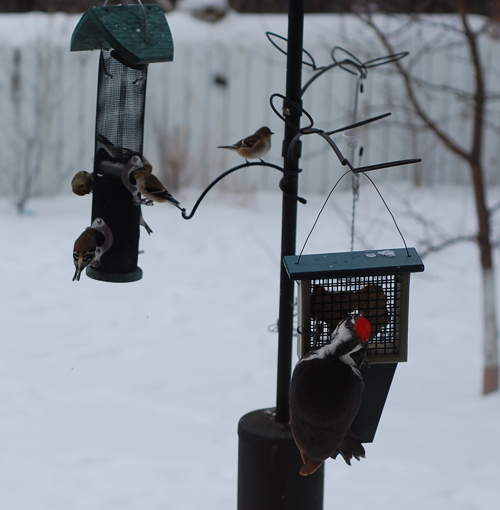 In case you have not heard, we're buried under an old school blizzard dumping up here. The local weather folk were predicting with barely restrained glee the potential for a massive storm. And though many of us have heard in the Twin Cities that we could get 1 - 2 feet of snow, many of us eyed this impending Snowmaggedon with skepticism. It often amounts to only a few inches. But to to be safe, I head out to Neil's for some last minute honey bottling finished--I need to get some together to mail to family for the holidays. I generally use birds at the feeder as an indication if the weather predictions are true. On Friday all feathers pointed to us getting seriously slammed on Saturday. The goldfinches were draining the thistle feeder and even the pileated woodpecker chowed down on the suet feeder closest to the window.
In case you have not heard, we're buried under an old school blizzard dumping up here. The local weather folk were predicting with barely restrained glee the potential for a massive storm. And though many of us have heard in the Twin Cities that we could get 1 - 2 feet of snow, many of us eyed this impending Snowmaggedon with skepticism. It often amounts to only a few inches. But to to be safe, I head out to Neil's for some last minute honey bottling finished--I need to get some together to mail to family for the holidays. I generally use birds at the feeder as an indication if the weather predictions are true. On Friday all feathers pointed to us getting seriously slammed on Saturday. The goldfinches were draining the thistle feeder and even the pileated woodpecker chowed down on the suet feeder closest to the window.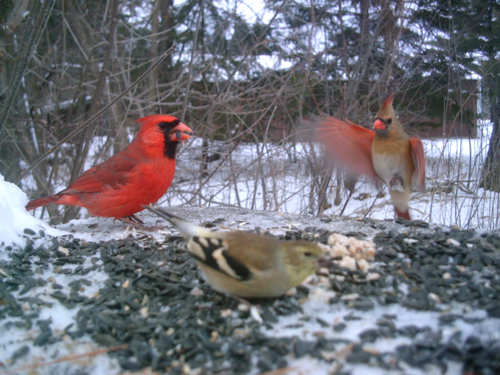
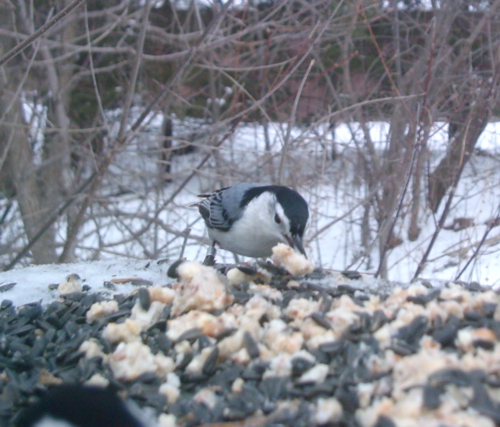
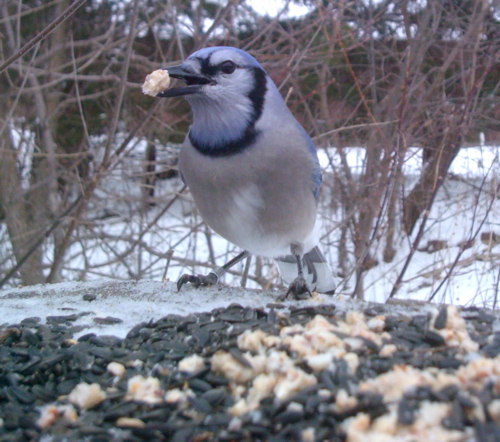
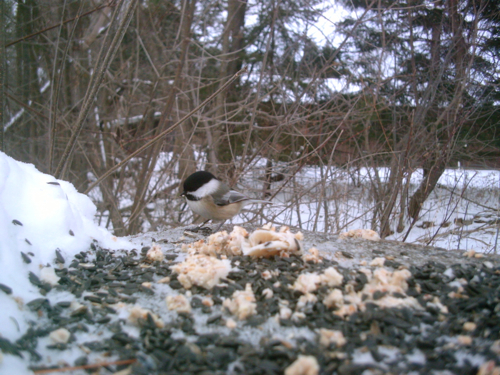
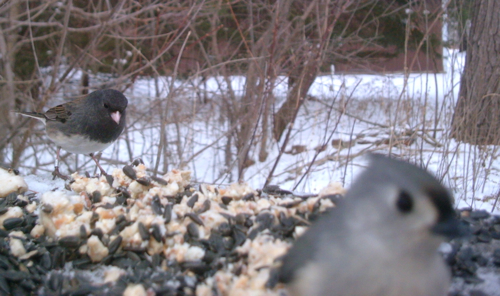
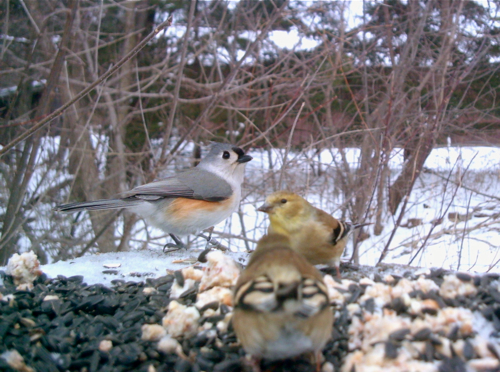
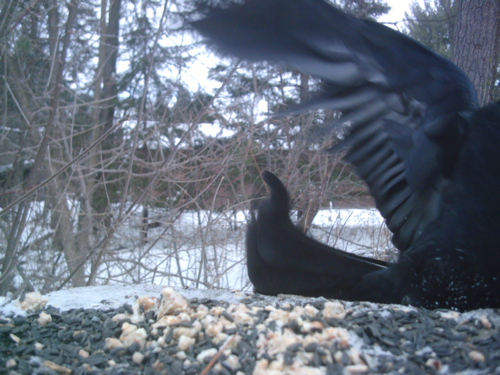
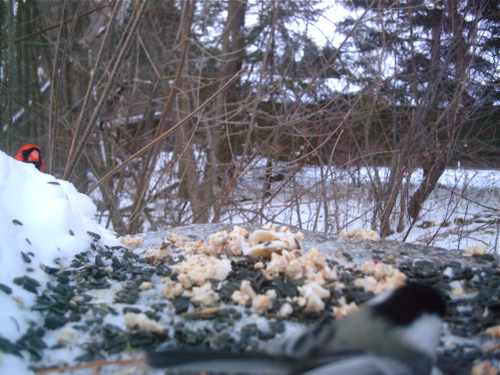
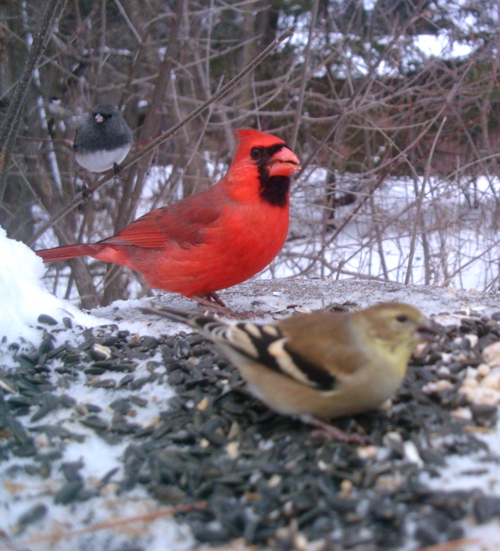

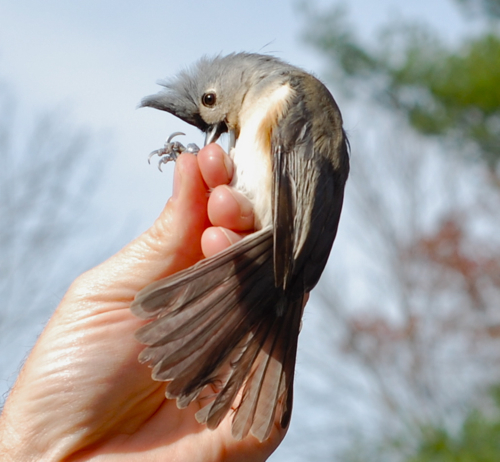
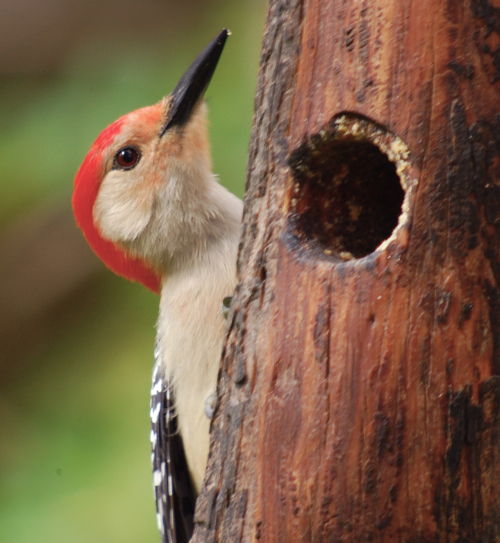 Twice a year I have some bird banding
Twice a year I have some bird banding 